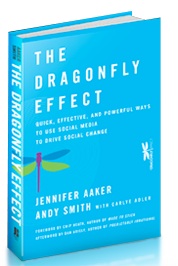Ideas That Take Flight on Social Media

How do some ideas take flight when others never get off the ground? What causes audiences to engage while being constantly bombarded with media images and stories? Stanford professor Jennifer Aaker seeks answers to these questions, and works to understand the core components to building powerful ideas that grab audiences and move them to action.
Aaker is co-author of The Dragonfly Effect, a book that guides individuals and organizations to use social media to advance social change. During her visit to the DFJ ETL seminar series, she shared principles to guide the crafting of stories and ideas in the social media sphere. It turns out that a person’s happiness can play a key role in how and when they choose to take action. However, happiness is not the same for everyone.
The Paradoxes of Happiness
The idea of happiness is more complex than you think, according to Aaker, who describes a number of happiness paradoxes. The first paradox is that individuals have varying conceptions of happiness, depending on factors such as age, gender, and culture. The second paradox is that each person’s conception of happiness constantly changes as they move through life. The third paradox is a false belief that meaning can be built solely through short-term happiness, when a mix of both short- and long-term happiness is required. In the following video, Aaker explains how the concept of happiness changes over a lifetime.
Create Environments That Allow for Happiness
Aaker believes a growing body of research shows that attaining a state of happiness often requires individuals to “unplug” from the search of trying to “find” happiness. Perhaps time and resources would be better spent on trying to create environments that allow for happiness to develop organically. If so, what would such an environment be built upon?
Aaker identifies three key factors that need to be present in environments to encourage happiness. The environment should:
- Enable people to build meaning
- Enable people to find connections
- Allow people to feel they are a part of something bigger
Aaker describes the happiness-enabling factors in this video.
Instant Brands and Social Action
As the shifting conception of happiness can mean different things to different people, sometimes delivering a compelling story to an audience can achieve meaning and subsequent action. Aaker illustrates this idea with the emotional story of Sameer Bhatia and Vinay Chakravarthy. When both men were diagnosed with leukemia, their friends led an integrated social media campaign to organize bone marrow drives in an effort to find good donor matches. Team Sameer and Team Vinay became instant brands, powered by web 2.0 tools and a compelling story, with the single goal of registering 20,000 individuals.
Sadly, even though good matches were found for both Sameer and Vinay, both men did eventually pass away from leukemia. However, in just 11 weeks, the social media campaign successfully resulted in the registration of over 24,000 South Asians, a group that is commonly underrepresented in the bone marrow registry. This type of lightening fast social action shows how a powerful, meaningful story can connect with audiences through social media, and drive audiences to make positive social change.
Learn about 100K Cheeks, a Stanford University-based advocacy group dedicated to increasing the number of people enrolled in the international bone marrow registry.



